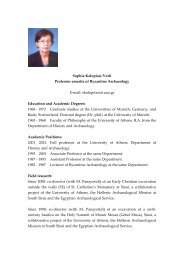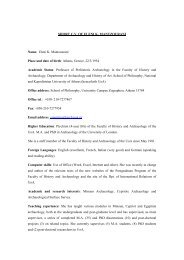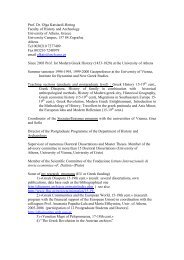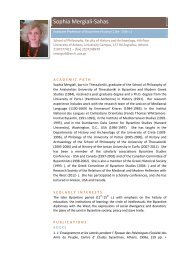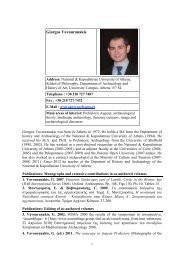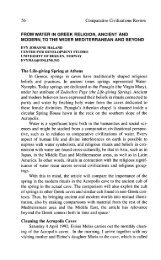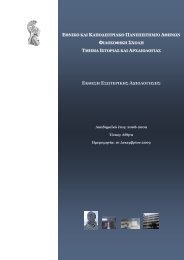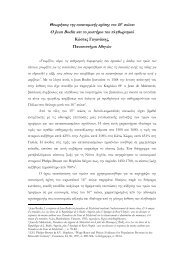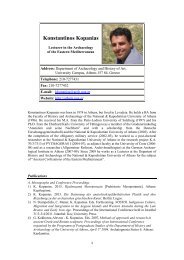The Dormition of the Virgin Mary on the Island of Tinos: A ...
The Dormition of the Virgin Mary on the Island of Tinos: A ...
The Dormition of the Virgin Mary on the Island of Tinos: A ...
You also want an ePaper? Increase the reach of your titles
YUMPU automatically turns print PDFs into web optimized ePapers that Google loves.
90 JOURNAL OF RELIGIOUS HISTORY<br />
<strong>on</strong> <str<strong>on</strong>g>the</str<strong>on</strong>g> Greek island <str<strong>on</strong>g>of</str<strong>on</strong>g> <strong>Tinos</strong>. It aims to explore some <str<strong>on</strong>g>of</str<strong>on</strong>g> <str<strong>on</strong>g>the</str<strong>on</strong>g> main elements <str<strong>on</strong>g>of</str<strong>on</strong>g><br />
this festival within a socio-ec<strong>on</strong>omic and political framework. 1<br />
In <str<strong>on</strong>g>the</str<strong>on</strong>g> Orthodox faith we meet <str<strong>on</strong>g>the</str<strong>on</strong>g> central miracle <str<strong>on</strong>g>of</str<strong>on</strong>g> childbirth, since <str<strong>on</strong>g>the</str<strong>on</strong>g><br />
Panagia above all is worshipped as a mo<str<strong>on</strong>g>the</str<strong>on</strong>g>r, and in modern Greece <str<strong>on</strong>g>the</str<strong>on</strong>g> festival<br />
dedicated to <str<strong>on</strong>g>the</str<strong>on</strong>g> “<str<strong>on</strong>g>Dormiti<strong>on</strong></str<strong>on</strong>g>” or “falling asleep” <str<strong>on</strong>g>of</str<strong>on</strong>g> <str<strong>on</strong>g>the</str<strong>on</strong>g> Panagia, <str<strong>on</strong>g>the</str<strong>on</strong>g> Bearer, or<br />
Mo<str<strong>on</strong>g>the</str<strong>on</strong>g>r <str<strong>on</strong>g>of</str<strong>on</strong>g> God (Ē Koimēsis tēs Yperagias <str<strong>on</strong>g>The</str<strong>on</strong>g>otokou, cf. Yperagias — <str<strong>on</strong>g>the</str<strong>on</strong>g> saint<br />
whoisover(yper — more, over) all <str<strong>on</strong>g>the</str<strong>on</strong>g> o<str<strong>on</strong>g>the</str<strong>on</strong>g>rs; <str<strong>on</strong>g>The</str<strong>on</strong>g>otokos — God-bearer or <str<strong>on</strong>g>the</str<strong>on</strong>g><br />
One who gives birth to God; Mētēr <str<strong>on</strong>g>The</str<strong>on</strong>g>otokou — Mo<str<strong>on</strong>g>the</str<strong>on</strong>g>r <str<strong>on</strong>g>of</str<strong>on</strong>g> God), is celebrated<br />
<strong>on</strong> 15 August, marking <str<strong>on</strong>g>the</str<strong>on</strong>g> end <str<strong>on</strong>g>of</str<strong>on</strong>g> <str<strong>on</strong>g>the</str<strong>on</strong>g> fifteen-day fast in h<strong>on</strong>our <str<strong>on</strong>g>of</str<strong>on</strong>g> <str<strong>on</strong>g>the</str<strong>on</strong>g> Panagia.<br />
<str<strong>on</strong>g>The</str<strong>on</strong>g> Feast <str<strong>on</strong>g>of</str<strong>on</strong>g> <str<strong>on</strong>g>the</str<strong>on</strong>g> <str<strong>on</strong>g>Dormiti<strong>on</strong></str<strong>on</strong>g> began around 600 CE and its celebrati<strong>on</strong> was fixed<br />
<strong>on</strong> 15 August by <str<strong>on</strong>g>the</str<strong>on</strong>g> Byzantine emperor Maurice; in Greek Orthodoxy it still<br />
retains <str<strong>on</strong>g>the</str<strong>on</strong>g> name. 2<br />
Summer-Festival Wishing a “Happy Winter” (kalos cheimōnas) 3<br />
August and particularly 1 August is c<strong>on</strong>sidered <str<strong>on</strong>g>the</str<strong>on</strong>g> beginning <str<strong>on</strong>g>of</str<strong>on</strong>g> a new seas<strong>on</strong><br />
in Greece, and since <str<strong>on</strong>g>the</str<strong>on</strong>g> festival dedicated to <str<strong>on</strong>g>the</str<strong>on</strong>g> <str<strong>on</strong>g>Dormiti<strong>on</strong></str<strong>on</strong>g> takes place after<br />
harvest and <str<strong>on</strong>g>the</str<strong>on</strong>g> threshing <str<strong>on</strong>g>of</str<strong>on</strong>g> <str<strong>on</strong>g>the</str<strong>on</strong>g> grain in a period <str<strong>on</strong>g>of</str<strong>on</strong>g> holiday and leisure, it also<br />
announces <str<strong>on</strong>g>the</str<strong>on</strong>g> passage from summer to winter and <str<strong>on</strong>g>the</str<strong>on</strong>g> new agricultural<br />
1. Since 1983 I have spent several periods <str<strong>on</strong>g>of</str<strong>on</strong>g> time doing fieldwork in <str<strong>on</strong>g>the</str<strong>on</strong>g> Mediterranean,<br />
mainly in Greece and Italy where I have also been c<strong>on</strong>ducting research <strong>on</strong> religious festivals<br />
since 1987, see E. J. Håland, Greek Festivals, Modern and Ancient: A Comparis<strong>on</strong> <str<strong>on</strong>g>of</str<strong>on</strong>g> Female<br />
and Male Values (Kristiansand: Norwegian Academic Press, 2007). An English versi<strong>on</strong>, translated<br />
by Dr Marie Wells and published by Cambridge Scholars Publishing, is forthcoming. In<br />
Greek Festivals, Modern and Ancient, <str<strong>on</strong>g>the</str<strong>on</strong>g> topics discussed in this article are examined fur<str<strong>on</strong>g>the</str<strong>on</strong>g>r.<br />
For brief overviews <str<strong>on</strong>g>of</str<strong>on</strong>g> <str<strong>on</strong>g>the</str<strong>on</strong>g> <str<strong>on</strong>g>Dormiti<strong>on</strong></str<strong>on</strong>g> festival, see E. J. Håland, “<str<strong>on</strong>g>The</str<strong>on</strong>g> Ritual Year as a Woman’s<br />
Life: <str<strong>on</strong>g>The</str<strong>on</strong>g> Festivals <str<strong>on</strong>g>of</str<strong>on</strong>g> <str<strong>on</strong>g>the</str<strong>on</strong>g> Agricultural Cycle, Life-Cycle Passages <str<strong>on</strong>g>of</str<strong>on</strong>g> Mo<str<strong>on</strong>g>the</str<strong>on</strong>g>r Goddesses and<br />
Fertility-Cult,” in First Internati<strong>on</strong>al C<strong>on</strong>ference <str<strong>on</strong>g>of</str<strong>on</strong>g> <str<strong>on</strong>g>the</str<strong>on</strong>g> SIEF Working Group <strong>on</strong> <str<strong>on</strong>g>The</str<strong>on</strong>g> Ritual Year.<br />
In Associati<strong>on</strong> with <str<strong>on</strong>g>The</str<strong>on</strong>g> Department <str<strong>on</strong>g>of</str<strong>on</strong>g> Maltese, University <str<strong>on</strong>g>of</str<strong>on</strong>g> Malta, Junior College, Msida,<br />
Malta, 2005: Proceedings, edited by G. Mifsud-Chircop (Malta: Publishers Enterprises Group<br />
Ltd, 2006), 303–26; E. J. Håland, “<str<strong>on</strong>g>The</str<strong>on</strong>g> Ritual Year <str<strong>on</strong>g>of</str<strong>on</strong>g> <str<strong>on</strong>g>the</str<strong>on</strong>g> Ic<strong>on</strong> <str<strong>on</strong>g>of</str<strong>on</strong>g> <str<strong>on</strong>g>the</str<strong>on</strong>g> Annunciati<strong>on</strong> <strong>on</strong> <str<strong>on</strong>g>the</str<strong>on</strong>g> <strong>Island</strong><br />
<str<strong>on</strong>g>of</str<strong>on</strong>g> <strong>Tinos</strong>, Greece,” Folklore; Electr<strong>on</strong>ic Journal <str<strong>on</strong>g>of</str<strong>on</strong>g> Folklore 47, (2011): 91–112; E. J. Håland,<br />
“Take Skamandros, my <str<strong>on</strong>g>Virgin</str<strong>on</strong>g>ity: Ideas <str<strong>on</strong>g>of</str<strong>on</strong>g> Water in C<strong>on</strong>necti<strong>on</strong> with Rites <str<strong>on</strong>g>of</str<strong>on</strong>g> Passage in Greece,<br />
Modern and Ancient,” in <str<strong>on</strong>g>The</str<strong>on</strong>g> Nature and Functi<strong>on</strong> <str<strong>on</strong>g>of</str<strong>on</strong>g> Water, Baths, Bathing, and Hygiene from<br />
Antiquity through <str<strong>on</strong>g>the</str<strong>on</strong>g> Renaissance, edited by C. Kosso and A. Scott (Leiden: Brill, 2009), 109–<br />
48. Since 1990 I have carried out extensive fieldwork <strong>on</strong> <strong>Tinos</strong>, and I witnessed <str<strong>on</strong>g>the</str<strong>on</strong>g> festival in<br />
1990, 1993–1998, and 2004–2011. Over <str<strong>on</strong>g>the</str<strong>on</strong>g> years I have interviewed several pilgrims as well as<br />
local inhabitants <strong>on</strong> <strong>Tinos</strong>, see Håland, Greek Festivals, Modern and Ancient, ch. 4, for an<br />
extensive presentati<strong>on</strong>. Some <str<strong>on</strong>g>of</str<strong>on</strong>g> my informants’ informati<strong>on</strong> is presented in this article, but<br />
space does not permit fur<str<strong>on</strong>g>the</str<strong>on</strong>g>r detail.<br />
2. See Håland, Greek Festivals, Modern and Ancient, 342, for references and discussi<strong>on</strong> <str<strong>on</strong>g>of</str<strong>on</strong>g> earlier<br />
festivals. <str<strong>on</strong>g>The</str<strong>on</strong>g>re are also differences in <str<strong>on</strong>g>the</str<strong>on</strong>g> way in which <str<strong>on</strong>g>Mary</str<strong>on</strong>g> is viewed in <str<strong>on</strong>g>the</str<strong>on</strong>g> Orthodox and<br />
Catholic churches. In <str<strong>on</strong>g>the</str<strong>on</strong>g> Orthodox church, <str<strong>on</strong>g>Mary</str<strong>on</strong>g> is not seen as immaculately c<strong>on</strong>ceived. In<br />
Orthodoxy, <str<strong>on</strong>g>the</str<strong>on</strong>g> virgin remains a human intercessor and a mo<str<strong>on</strong>g>the</str<strong>on</strong>g>r, see article for discussi<strong>on</strong> <str<strong>on</strong>g>of</str<strong>on</strong>g> this<br />
aspect. Cf. J. Dubisch, In a Different Place: Pilgrimage, Gender, and Politics at a Greek <strong>Island</strong><br />
Shrine (Princet<strong>on</strong>: Princet<strong>on</strong> University Press, 1995), 236; M. Alexiou, After Antiquity: Greek<br />
Language, Myth, and Metaphor (Ithaca, NY: Cornell University Press, 2002), 354. See also I.<br />
Ec<strong>on</strong>omides, Differences between <str<strong>on</strong>g>the</str<strong>on</strong>g> Orthodox Church and Roman Catholicism (A<str<strong>on</strong>g>the</str<strong>on</strong>g>ns, 1986).<br />
According to T. Ware, <str<strong>on</strong>g>The</str<strong>on</strong>g> Orthodox Church (L<strong>on</strong>d<strong>on</strong>: Penguin Books, 1991), 264 n.1, <str<strong>on</strong>g>the</str<strong>on</strong>g>re are<br />
also differences within <str<strong>on</strong>g>the</str<strong>on</strong>g> Orthodox Church, and <str<strong>on</strong>g>the</str<strong>on</strong>g> Assumpti<strong>on</strong> has never been proclaimed as a<br />
dogma. On <strong>Tinos</strong> <str<strong>on</strong>g>the</str<strong>on</strong>g> celebrati<strong>on</strong> <strong>on</strong> 15 August is followed by <str<strong>on</strong>g>the</str<strong>on</strong>g> burial <str<strong>on</strong>g>of</str<strong>on</strong>g> <str<strong>on</strong>g>the</str<strong>on</strong>g> Panagia nine days<br />
after her death/sleep; see infra.<br />
3. Literally kalos means good, but I have provided a translati<strong>on</strong> that sounds better in English. <str<strong>on</strong>g>The</str<strong>on</strong>g><br />
transliterati<strong>on</strong> <str<strong>on</strong>g>of</str<strong>on</strong>g> Greek follows <str<strong>on</strong>g>the</str<strong>on</strong>g> rules <str<strong>on</strong>g>of</str<strong>on</strong>g> <str<strong>on</strong>g>the</str<strong>on</strong>g> Nordic Library, A<str<strong>on</strong>g>the</str<strong>on</strong>g>ns.<br />
© 2012 <str<strong>on</strong>g>The</str<strong>on</strong>g> Author<br />
Journal <str<strong>on</strong>g>of</str<strong>on</strong>g> Religious History © 2012 Religious History Associati<strong>on</strong>



